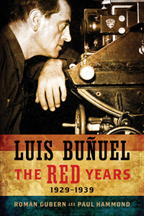The University of Wisconsin Press
Film / Biography / European Studies
Luis Buñuel Wisconsin Film Studies The turbulent years of the 1930s were of profound importance in the life of Spanish film director Luis Buñuel (1900–1983). He joined the Surrealist movement in 1929 but by 1932 had renounced it and embraced Communism. During the Spanish Civil War (1936–39), he played an integral role in disseminating film propaganda in Paris for the Spanish Republican cause. Román Gubern is professor at the Universitat Autónoma de Barcelona and has been a guest researcher at MIT. He is author of numerous screenplays for film and television and of more than forty books on cinema, popular culture, and semiotics, including 1936–1939: La Guerra de España en la pantalla. Paul Hammond is author and editor of several books, including The Shadow and Its Shadow: Surrealist Writings on the Cinema. Among his many translations is A Panorama of American Film Noir by Borde and Chaumeton. Both authors live in Barcelona. Praise “Gubern and Hammond’s book is of course about Buñuel . . . but it is also about other aspects of those years: social fears and social change, the Surrealist movement, the paradigm shift that the advent of ‘talkies’ would bring to cinema, Republican propaganda during the Spanish Civil War, the diverging paths that Spain’s early film production companies (Filmófono and Cifesa) would take, and, ultimately, about the choices that artists like Buñuel faced in the 1930s.” “The period in Luis Buñuel’s career between 1930 (L’Âge d’or) and 1938, when he left Europe and went into exile, is the one we know the least about. From Gubern (an expert in Spanish cinema) and Hammond (an expert on Surrealism), we learn a great deal we didn’t know about his filmmaking, and about how it was intertwined with his politics.” Media & bookseller inquiries regarding review copies, events, and interviews can be directed to the publicity department at publicity@uwpress.wisc.edu or (608) 263-0734. (If you want to examine a book for possible course use, please see our Course Books page. If you want to examine a book for possible rights licensing, please see Rights & Permissions.) |
2009 Spanish edition, Los años rojos de Luis Buñuel, published by Catedra. |
|||||||||
|
If you have trouble accessing
any page in this web site, contact our Web manager. Updated 03/09/2015 © 2011, The Board of Regents of the University of Wisconsin System |
